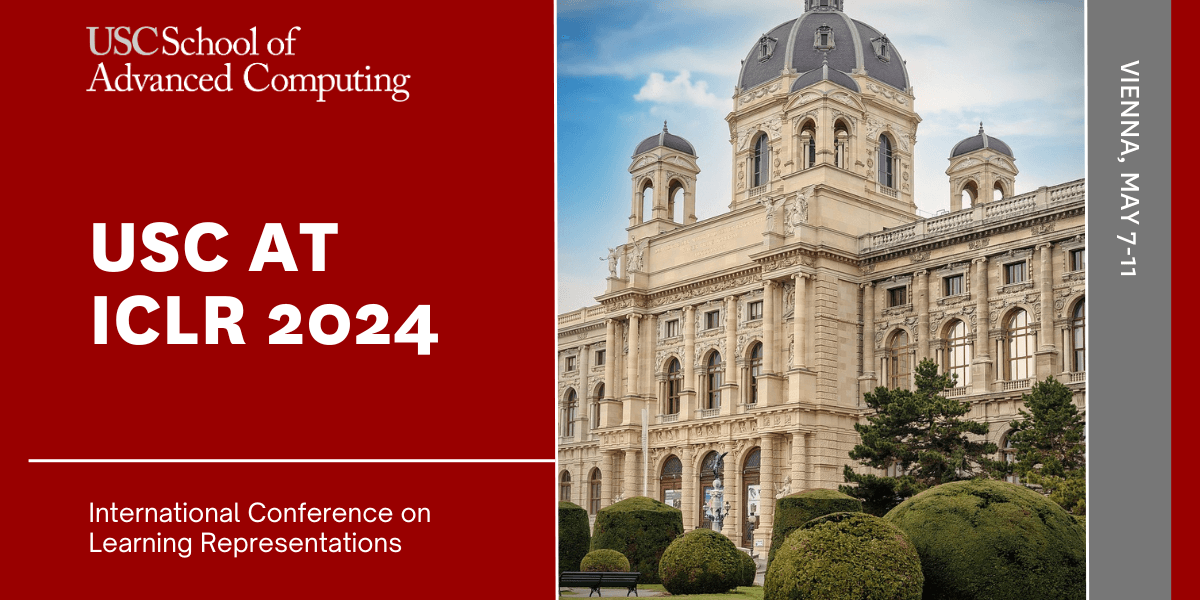
The International Conference on Learning Representations (ICLR) takes place in Vienna, Austria, May 7-11.
Researchers from the USC School of Advanced Computing, a unit of the USC Viterbi School of Engineering, are presenting 14 papers at the International Conference on Learning Representations (ICLR), a premier gathering of professionals dedicated to the advancement of the branch of artificial intelligence called representation learning, commonly referred to as deep learning. These include faculty and students from the Thomas Lord Department of Computer Science and the Ming Hsieh Department of Computer Science and Electrical Engineering.
RESEARCH
ORAL papers are approximately in the top 1%, and SPOTLIGHT papers are in the top 6% of accepted papers.
Datasets and benchmarks
WildChat: 1M ChatGPT Interaction Logs in the Wild (SPOTLIGHT)
Wenting Zhao, Xiang Ren, Jack Hessel, Claire Cardie, Yejin Choi, Yuntian Deng
The past decade has witnessed significant advances in time series modeling with deep learning. While achieving state-of-the-art results, the best-performing architectures vary highly across applications and domains. Meanwhile, for natural language processing, the Generative Pre-trained Transformer (GPT) has demonstrated impressive performance via training one general-purpose model across various textual datasets. It is intriguing to explore whether GPT-type architectures can be effective for time series, capturing the intrinsic dynamic attributes and leading to significant accuracy improvements. In this paper, we propose a novel framework, TEMPO, that can effectively learn time series representations. We focus on utilizing two essential inductive biases of the time series task for pre-trained models: (i) decomposition of the complex interaction between trend, seasonal and residual components; and (ii) introducing the design of prompts to facilitate distribution adaptation in different types of time series. TEMPO expands the capability for dynamically modeling real-world temporal phenomena from data within diverse domains. Our experiments demonstrate the superior performance of TEMPO over state-of-the-art methods on zero shot setting for a number of time series benchmark datasets. This performance gain is observed not only in scenarios involving previously unseen datasets but also in scenarios with multi-modal inputs. This compelling finding highlights TEMPO’s potential to constitute a foundational model-building framework.
General machine learning
Linlu Qiu, Liwei Jiang, Ximing Lu, Melanie Sclar, Valentina Pyatkin, Chandra Bhagavatula, Bailin Wang, Yoon Kim, Yejin Choi, Nouha Dziri, Xiang Ren
The ability to derive underlying principles from a handful of observations and then generalize to novel situations — known as inductive reasoning — is central to human intelligence. Prior work suggests that language models (LMs) often fall short on inductive reasoning, despite achieving impressive success on research benchmarks. In this work, we conduct a systematic study of the inductive reasoning capabilities of LMs through iterative hypothesis analysis, a technique that more closely mirrors the human inductive process than standard input-output prompting. Iterative hypothesis refinement employs a three-step process: proposing, selecting, and refining hypotheses in the form of textual rules. By examining the intermediate rules, we observe that LMs are phenomenal hypothesis proposers (i.e., generating candidate rules), and when coupled with a (task-specific) symbolic interpreter that is able to systematically filter the proposed set of rules, this hybrid approach achieves strong results across inductive reasoning benchmarks that require inducing causal relations, language-like instructions, and symbolic concepts. However, they also behave as puzzling. Inductive reasoners, showing notable performance gaps between rule induction (i.e., identifying plausible rules) and rule application (i.e., applying proposed rules to instances), suggesting that LMs are proposing hypotheses without being able to actually apply the rules. Through empirical and human analyses, we further reveal several discrepancies between the inductive reasoning processes of LMs and humans, shedding light on both the potentials and limitations of using LMs in inductive reasoning tasks.
Gourav Datta, Zeyu Liu, Peter Beerel
Binary neural networks (BNN) have emerged as an attractive computing paradigm for a wide range of low-power vision tasks. However, state-of-the-art (SOTA) BNNs do not yield any sparsity, and induce a significant number of non-binary operations. On the other hand, activation sparsity can be provided by spiking neural networks (SNN), that too have gained significant traction in recent times. Thanks to this sparsity, SNNs when implemented on neuromorphic hardware, have the potential to be significantly more power-efficient compared to traditional artificIal neural networks (ANN). However, SNNs incur multiple time steps to achieve close to SOTA accuracy. Ironically, this increases latency and energy—costs that SNNs were proposed to reduce—and presents itself as a major hurdle in realizing SNNs’ theoretical gains in practice. This raises an intriguing question: Can we obtain SNN-like sparsity and BNN-like accuracy and enjoy the energy-efficiency benefits of both? To answer this question, in this paper, we present a training framework for sparse binary activation neural networks (BANN) using a novel variant of the Hoyer regularizer. We estimate the threshold of each BANN layer as the Hoyer extremum of a clipped version of its activation map, where the clipping value is trained using gradient descent with our Hoyer regularizer. This approach shifts the activation values away from the threshold, thereby mitigating the effect of noise that can otherwise degrade the BANN accuracy. Our approach outperforms existing BNNs, SNNs, and adder neural networks (that also avoid energy-expensive multiplication operations similar to BNNs and SNNs) in terms of the accuracy-FLOPs trade-off for complex image recognition tasks. Downstream experiments on object detection further demonstrate the efficacy of our approach. Lastly, we demonstrate the portability of our approach to SNNs with multiple time steps. Codes are publicly available here.
LMUFormer: Low Complexity Yet Powerful Spiking Model With Legendre Memory Units
Zeyu Liu, Gourav Datta, Anni Li, Peter Beerel
Transformer models have demonstrated high accuracy in numerous applications but have high complexity and lack sequential processing capability making them ill-suited for many streaming applications at the edge where devices are heavily resource-constrained. Thus motivated, many researchers have proposed reformulating the transformer models as RNN modules which modify the self-attention computation with explicit states. However, these approaches often incur significant performance degradation.The ultimate goal is to develop a model that has the following properties: parallel training, streaming and low-cost inference, and state-of-the-art (SOTA) performance. In this paper, we propose a new direction to achieve this goal. We show how architectural modifications to a fully-sequential recurrent model can help push its performance toward Transformer models while retaining its sequential processing capability. Specifically, inspired by the recent success of Legendre Memory Units (LMU) in sequence learning tasks, we propose LMUFormer, which augments the LMU with convolutional patch embedding and convolutional channel mixer. Moreover, we present a spiking version of this architecture, which introduces the benefit of states within the patch embedding and channel mixer modules while simultaneously reducing the computing complexity. We evaluated our architectures on multiple sequence datasets. Of particular note is our performance on the Speech Commands V2 dataset (35 classes). In comparison to SOTA transformer-based models within the ANN domain, our LMUFormer demonstrates comparable performance while necessitating a remarkable 70× reduction in parameters and a substantial 140× decrement in FLOPs. Furthermore, when benchmarked against extant low-complexity SNN variants, our model establishes a new SOTA with an accuracy of 96.12\%. Additionally, owing to our model’s proficiency in real-time data processing, we are able to achieve a 32.03\% reduction in sequence length, all while incurring an inconsequential decline in performance.
Neuro-Inspired Information-Theoretic Hierarchical Perception for Multimodal Learning
Xiongye Xiao, Gengshuo Liu, Gaurav Gupta, Defu Cao, Shixuan Li, Yaxing Li, Tianqing Fang, Mingxi Cheng, Paul Bogdan
Integrating and processing information from various sources or modalities are critical for obtaining a comprehensive and accurate perception of the real world in autonomous systems and cyber-physical systems. Drawing inspiration from neuroscience, we develop the Information-Theoretic Hierarchical Perception (ITHP) model, which utilizes the concept of information bottleneck. Different from most traditional fusion models that incorporate all modalities identically in neural networks, our model designates a prime modality and regards the remaining modalities as detectors in the information pathway, serving to distill the flow of information. Our proposed perception model focuses on constructing an effective and compact information flow by achieving a balance between the minimization of mutual information between the latent state and the input modal state, and the maximization of mutual information between the latent states and the remaining modal states. This approach leads to compact latent state representations that retain relevant information while minimizing redundancy, thereby substantially enhancing the performance of multimodal representation learning. Experimental evaluations on the MUStARD, CMU-MOSI, and CMU-MOSEI datasets demonstrate that our model consistently distills crucial information in multimodal learning scenarios, outperforming state-of-the-art benchmarks. Remarkably, on the CMU-MOSI dataset, ITHP surpasses human-level performance in the multimodal sentiment binary classification task across all evaluation metrics (i.e., Binary Accuracy, F1 Score, Mean Absolute Error, and Pearson Correlation).
Learning theory
Towards Establishing Guaranteed Error for Learned Database Operations
Sepanta Zeighami, Cyrus Shahabi
Machine learning models have demonstrated substantial performance enhancements over non-learned alternatives in various fundamental data management operations, including indexing (locating items in an array), cardinality estimation (estimating the number of matching records in a database), and range-sum estimation (estimating aggregate attribute values for query-matched records). However, real-world systems frequently favor less efficient non-learned methods due to their ability to offer (worst-case) error guarantees — an aspect where learned approaches often fall short. The primary objective of these guarantees is to ensure system reliability, ensuring that the chosen approach consistently delivers the desired level of accuracy across all databases. In this paper, we embark on the first theoretical study of such guarantees for learned methods, presenting the necessary conditions for such guarantees to hold when using machine learning to perform indexing, cardinality estimation and range-sum estimation. Specifically, we present the first known lower bounds on the model size required to achieve the desired accuracy for these three key database operations. Our results bound the required model size for given average and worst-case errors in performing database operations, serving as the first theoretical guidelines governing how model size must change based on data size to be able to guarantee an accuracy level. More broadly, our established guarantees pave the way for the broader adoption and integration of learned models into real-world systems.
Probabilistic methods
Closing the Curious Case of Neural Text Degeneration
Matthew Finlayson, John Hewitt, Alexander Koller, Swabha Swayamdipta, Ashish Sabharwal
Despite their ubiquity in language generation, it remains unknown why truncation sampling heuristics like nucleus sampling are so effective. We provide a theoretical explanation for the effectiveness of the truncation sampling by proving that truncation methods that discard tokens below some probability threshold (the most common type of truncation) can guarantee that all sampled tokens have nonzero true probability. However, thresholds are a coarse heuristic, and necessarily discard some tokens with nonzero true probability as well. In pursuit of a more precise sampling strategy, we show that we can leverage a known source of model errors, the softmax bottleneck, to prove that certain tokens have nonzero true probability, without relying on a threshold. Based on our findings, we develop an experimental truncation strategy and the present pilot studies demonstrating the promise of this type of algorithm. Our evaluations show that our method outperforms its threshold-based counterparts under automatic and human evaluation metrics for low-entropy (i.e., close to greedy) open-ended text generation. Our theoretical findings and pilot experiments provide both insight into why truncation sampling works, and make progress toward more expressive sampling algorithms that better surface the generative capabilities of large language models.
Explain like I’m five: Matthew Finlayson

“We explain why language models, especially small ones, make prediction mistakes, then find a new way to predict when they will make those mistakes and avoid them. Our research helps make small language models, like the ones that Apple is releasing that can run on your phone, more reliable. Anyone who needs to use language models without an internet connection may need to use a small model that can fit on their device. Our method will help make those small models less likely to make mistakes.”
Reinforcement learning
Proximal Policy Gradient Arborescence for Quality Diversity Reinforcement Learning (SPOTLIGHT)
Sumeet Batra, Bryon Tjanaka, Matthew Christopher Fontaine, Aleksei Petrenko, Stefanos Nikolaidis, Gaurav S. Sukhatme
Training generally capable agents that thoroughly explore their environment and learn new and diverse skills is a long-term goal of robot learning. Quality Diversity Reinforcement Learning (QD-RL) is an emerging research area that blends the best aspects of both fields – Quality Diversity (QD) provides a principled form of exploration and produces collections of behaviorally diverse agents, while Reinforcement Learning (RL) provides a powerful performance improvement operator enabling generalization across tasks and dynamic environments. Existing QD-RL approaches have been constrained to sample efficient, deterministic off-policy RL algorithms and/or evolution strategies and struggle with highly stochastic environments. In this work, we, for the first time, adapt on-policy RL, specifically Proximal Policy Optimization (PPO), to the Differentiable Quality Diversity (DQD) framework and propose several changes that enable efficient optimization and discovery of novel skills on high-dimensional, stochastic robotics tasks. Our new algorithm, Proximal Policy Gradient Arborescence (PPGA), achieves state-of- the-art results, including a 4x improvement in best reward over baselines on the challenging humanoid domain.
Explain like I’m five: Sumeet Batra
“In this paper, we develop an algorithm that allows robots in simulation to discover new ways of moving, including walking, running, galloping, hopping on one leg, and limping. Our paper achieves promising results in making AI for humanoid robots more reliable and adaptable to the complexity of the world, bringing us one step closer to having helpful humanoid robot assistants in our households and workplaces. We are in the works of bringing this to a real robot for a future paper!”
Representation learning for computer vision, audio, language, and other modalities
TEMPO: Prompt-based Generative Pre-trained Transformer for Time Series Forecasting
Defu Cao, Furong Jia, Sercan O Arik, Tomas Pfister, Yixiang Zheng, Wen Ye, Yan Liu
The past decade has witnessed significant advances in time series modeling with deep learning. While achieving state-of-the-art results, the best-performing architectures vary highly across applications and domains. Meanwhile, for natural language processing, the Generative Pre-trained Transformer (GPT) has demonstrated impressive performance via training one general-purpose model across various textual datasets. It is intriguing to explore whether GPT-type architectures can be effective for time series, capturing the intrinsic dynamic attributes and leading to significant accuracy improvements. In this paper, we propose a novel framework, TEMPO, that can effectively learn time series representations. We focus on utilizing two essential inductive biases of the time series task for pre-trained models: (i) decomposition of the complex interaction between trend, seasonal and residual components; and (ii) introducing the design of prompts to facilitate distribution adaptation in different types of time series. TEMPO expands the capability for dynamically modeling real-world temporal phenomena from data within diverse domains. Our experiments demonstrate the superior performance of TEMPO over state-of-the-art methods on zero shot setting for a number of time series benchmark datasets. This performance gain is observed not only in scenarios involving previously unseen datasets but also in scenarios with multi-modal inputs. This compelling finding highlights TEMPO’s potential to constitute a foundational model-building framework.
Tailoring Self-Rationalizers with Multi-Reward Distillation
Sahana Ramnath, Brihi Joshi, Skyler Hallinan, Ximing Lu, Liunian Li, Aaron Chan, Jack Hessel, Yejin Choi, Xiang Ren
Large language models (LMs) are capable of generating free-text rationales to aid question answering. However, prior work 1) suggests that useful self-rationalization is emergent only at significant scales (e.g., 175B parameter GPT-3); and 2) focuses largely on downstream performance, ignoring the semantics of the rationales themselves, e.g., are they faithful, true, and helpful for humans? In this work, we enable small-scale LMs (∼200x smaller than GPT-3) to generate rationales that not only improve downstream task performance, but are also more plausible, consistent, and diverse, assessed both by automatic and human evaluation. Our method, MaRio (Multi-rewArd RatIOnalization), is a multi-reward conditioned self-rationalization algorithm that optimizes multiple distinct properties like plausibility, diversity and consistency. Results on three difficult question-answering datasets StrategyQA, QuaRel and OpenBookQA show that not only does MaRio improve task accuracy, but it also improves the self-rationalization quality of small LMs across the aforementioned axes better than a supervised fine-tuning (SFT) baseline. Extensive human evaluations confirm that MaRio rationales are preferred vs. SFT rationales, as well as qualitative improvements in plausibility and consistency.
PlaSma: Procedural Knowledge Models for Language-based Planning and Re-Planning
Faeze Brahman, Chandra Bhagavatula, Valentina Pyatkin, Jena Hwang, Xiang Lorraine Li, Hirona Arai, Soumya Sanyal, Keisuke Sakaguchi, Xiang Ren, Yejin Choi
Procedural planning, which entails decomposing a high-level goal into a sequence of temporally ordered steps, is an important yet intricate task for machines. It involves integrating common-sense knowledge to reason about complex and often contextualized situations, e.g. “scheduling a doctor’s appointment without a phone.” While current approaches show encouraging results using large language models (LLMs), they are hindered by drawbacks such as costly API calls and reproducibility issues. In this paper, we advocate planning using smaller language models. We present PlaSma, a novel two-pronged approach to endow small language models with procedural knowledge and (constrained) language-based planning capabilities. More concretely, we develop symbolic procedural knowledge distillation to enhance the commonsense knowledge in small language models and an inference-time algorithm to facilitate more structured and accurate reasoning. In addition, we introduce a new related task, Replanning, that requires a revision of a plan to cope with a constrained situation. In both the planning and replanning settings, we show that orders-of-magnitude smaller models (770M-11B parameters) can compete and often surpass their larger teacher models’ capabilities. Finally, we showcase successful application of PlaSma in an embodied environment, VirtualHome.
EmerNeRF: Emergent Spatial-Temporal Scene Decomposition via Self-Supervision
Jiawei Yang, Boris Ivanovic, Or Litany, Xinshuo Weng, Seung Wook Kim, Boyi Li, Tong Che, Danfei Xu, Sanja Fidler, Marco Pavone, Yue Wang
We present EmerNeRF, a simple yet powerful approach for learning spatial-temporal representations of dynamic driving scenes. Grounded in neural fields, EmerNeRF simultaneously captures scene geometry, appearance, motion, and semantics via self-bootstrapping. EmerNeRF hinges upon two core components: First, it stratifies scenes into static and dynamic fields. This decomposition emerges purely from self-supervision, enabling our model to learn from general, in-the-wild data sources. Second, EmerNeRF parameterizes an induced flow field from the dynamic field and uses this flow field to further aggregate multi-frame features, amplifying the rendering precision of dynamic objects. Coupling these three fields (static, dynamic, and flow) enables EmerNeRF to represent highly-dynamic scenes self-sufficiently, without relying on ground truth object annotations or pre-trained models for dynamic object segmentation or optical flow estimation. Our method achieves state-of-the-art performance in sensor simulation, significantly outperforming previous methods when reconstructing static (+2.93 PSNR) and dynamic (+3.70 PSNR) scenes. In addition, to bolster EmerNeRF’s semantic generalization, we lift 2D visual foundation model features into 4D space-time and address a general positional bias in modern Transformers, significantly boosting 3D perception performance (e.g., 37.50% relative improvement in occupancy prediction accuracy on average). Finally, we construct a diverse and challenging 120-sequence dataset to benchmark neural fields under extreme and highly-dynamic settings.
Transfer learning, meta learning and lifelong learning
Yavuz Faruk Bakman, Duygu Nur Yaldiz, Yahya Ezzeldin, Salman Avestimehr
Federated learning (FL) has gained significant attraction due to its ability to enable privacy-preserving training over decentralized data. Current literature in FL mostly focuses on single-task learning. However, over time, new tasks may appear in the clients and the global model should learn these tasks without forgetting previous tasks. This real-world scenario is known as Continual Federated Learning (CFL). The main challenge of CFL is Global Catastrophic Forgetting, which corresponds to the fact that when the global model is trained on new tasks, its performance on old tasks decreases. There have been a few recent works on CFL to propose methods that aim to address the global catastrophic forgetting problem. However, these works either have unrealistic assumptions on the availability of past data samples or violate the privacy principles of FL. We propose a novel method, Federated Orthogonal Training (FOT), to overcome these drawbacks and address the global catastrophic forgetting in CFL. Our algorithm extracts the global input subspace of each layer for old tasks and modifies the aggregated updates of new tasks such that they are orthogonal to the global principal subspace of old tasks for each layer. This decreases the interference between tasks, which is the main cause for forgetting. Our method is almost computation-free on the client side and has negligible communication cost. We empirically show that FOT outperforms state-of-the-art continual learning methods in the CFL setting, achieving an average accuracy gain of up to 15% with 27% lower forgetting while only incurring a minimal computation and communication cost. Code can be found here.
Visualization or interpretation of learned representations
Interpretable Diffusion via Information Decomposition
Xianghao Kong, Ollie Liu, Han Li, Dani Yogatama, Greg Ver Steeg
Denoising diffusion models enable conditional generation and density modeling of complex relationships like images and text. However, the nature of the learned relationships is opaque making it difficult to understand precisely what relationships between words and parts of an image are captured, or to predict the effect of an intervention. We illuminate the fine-grained relationships learned by diffusion models by noticing a precise relationship between diffusion and information decomposition. Exact expressions for mutual information and conditional mutual information can be written in terms of the denoising model. Furthermore, estimates can be easily estimated as well, allowing us to ask questions about the relationships between specific images and captions. Decomposing information even further to understand which variables in a high-dimensional space carry information is a long-standing problem. For diffusion models, we show that a natural non-negative decomposition of mutual information emerges, allowing us to quantify informative relationships between words and pixels in an image. We exploit these new relations to measure the compositional understanding of diffusion models, to do unsupervised localization of objects in images, and to measure effects when selectively editing images through prompt interventions.
Published on May 7th, 2024
Last updated on May 16th, 2024














